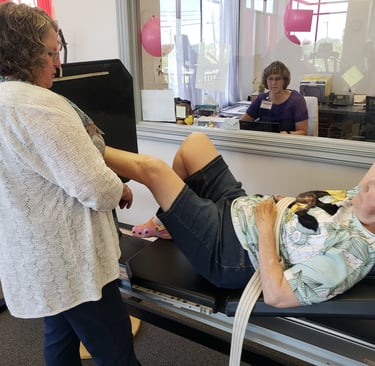The Importance of Therapy in Stroke Recovery
Therapy plays a crucial role in the recovery process for individuals who have experienced a stroke. There are two main types of therapy that are commonly used: physical therapy and occupational therapy.
Thomas
10/27/20232 min read


The Importance of Therapy in Stroke Recovery
Therapy plays a crucial role in the recovery process for individuals who have experienced a stroke. There are two main types of therapy that are commonly used: physical therapy and occupational therapy. Each type of therapy focuses on different aspects of the recovery process and helps stroke survivors regain their independence and improve their quality of life.
Physical Therapy
Physical therapy is a type of therapy that focuses on improving physical function and mobility. It is usually one of the first types of therapy that stroke survivors receive after their initial medical treatment. Physical therapy helps individuals regain strength, coordination, and balance, which are often affected by a stroke. The goal of physical therapy is to help stroke survivors regain their ability to perform everyday tasks, such as walking, climbing stairs, and getting in and out of bed.
During physical therapy sessions, stroke survivors may participate in exercises that target specific muscle groups, as well as activities that simulate real-life movements. Physical therapists may also use assistive devices, such as walkers or canes, to help stroke survivors improve their mobility. The duration and intensity of physical therapy sessions may vary depending on the individual's needs and progress.
Occupational Therapy
Occupational therapy focuses on helping stroke survivors regain their ability to perform activities of daily living, such as dressing, eating, and bathing. Occupational therapists work with individuals to develop strategies and techniques that will enable them to complete these tasks independently.
During occupational therapy sessions, stroke survivors may practice using adaptive equipment, such as modified utensils or dressing aids, to help them perform daily tasks more easily. Occupational therapists may also provide guidance on energy conservation techniques and teach individuals how to modify their home environment to make it more accessible and safe.
The Benefits of Therapy in Stroke Recovery
Both physical therapy and occupational therapy offer numerous benefits to stroke survivors. Some of the key benefits include:
Improved Mobility: Physical therapy helps stroke survivors regain strength, coordination, and balance, allowing them to move more easily and independently.
Enhanced Independence: Occupational therapy focuses on helping individuals regain their ability to perform daily tasks, enabling them to live more independently.
Reduced Risk of Complications: Therapy can help reduce the risk of complications, such as muscle stiffness, contractures, and pressure ulcers, which are common after a stroke.
Increased Quality of Life: By improving physical function and independence, therapy can greatly enhance a stroke survivor's overall quality of life.
Getting Started with Therapy
If you or a loved one has experienced a stroke, it is important to discuss therapy options with your healthcare provider. They can help determine which type of therapy is most appropriate and refer you to a qualified therapist.
Remember, therapy is a vital component of stroke recovery and can make a significant difference in a person's ability to regain function and independence. With the help of physical therapy and occupational therapy, stroke survivors can achieve their goals and lead fulfilling lives.
